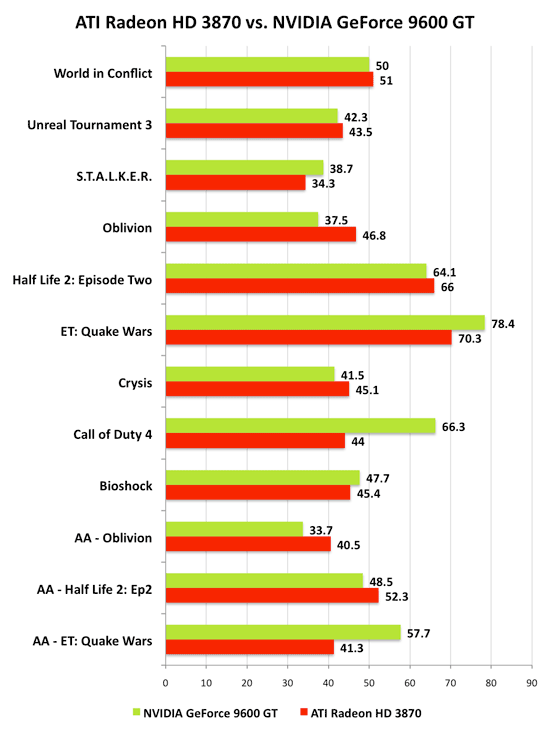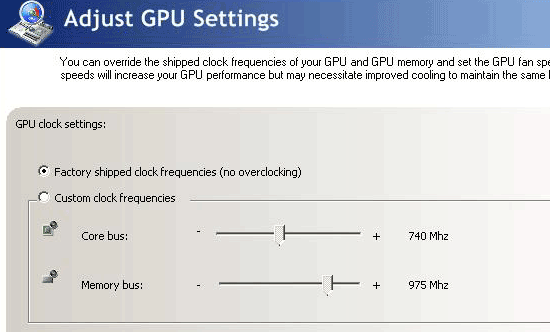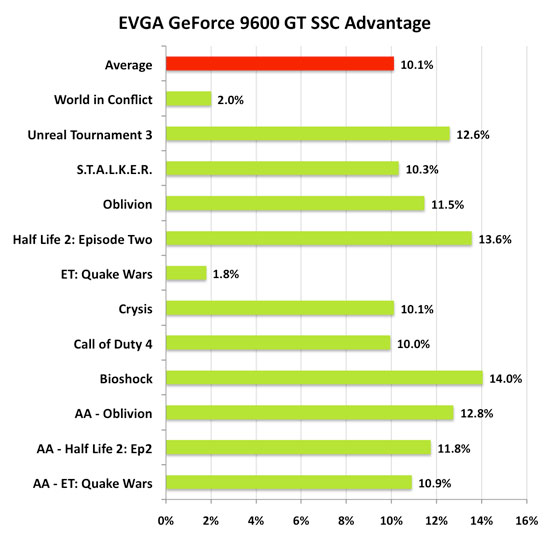
Original Link: https://www.anandtech.com/show/2454
When the Smoke Clears & Prices Settle: GeForce 9600 GT vs. Radeon HD 3870
by Anand Lal Shimpi on February 22, 2008 12:00 AM EST- Posted in
- GPUs
Yesterday saw the introduction of NVIDIA’s GeForce 9 series of GPUs, starting with the GeForce 9600 GT. Carrying a MSRP of $169 - $189, the GeForce 9600 GT was designed to fill a void in NVIDIA’s product lineup. The GeForce 8600, NVIDIA’s original sub-$200 competitor was being sorely beaten by AMD’s Radeon HD 3850. The GeForce 9600 GT was introduced to rectify the situation.
Had the world remained the same, the GeForce 9600 GT would have competed with and done a good job of destroying the Radeon HD 3850. However, AMD didn’t remain still and quietly reduced the prices of its Radeon HD 3800 series GPUs in the channel. The GeForce 9600 GT no longer was a competitor of the Radeon HD 3850, but rather up against the 3870.
A 256MB Radeon HD 3850 will set you back around $150, while the 512MB models are $170 parts. Stock clocked GeForce 9600 GTs are doing a good job of hovering right at $179.99, while factory overclocked cards will set you back closer to $200. The Radeon HD 3870 has now dropped to below $200 and we even found one for about the same price as a 9600 GT. The table below is a small sample of what we found at some popular e-tailers:
| Vendor | ATI Radeon HD 3870 | NVIDIA GeForce 9600 GT | eVGA GeForce 9600 GT SSC |
| Newegg | $184.99 | $179.99 | $209.99 |
| mwave | $209.90 | $179.90 | N/A |
| NCIX | $189.92 | $179.00 | $204.13 |
| Tiger Direct | $199.99 | $199.99 | N/A |
| ZipZoomfly | $224.99 | $179.99 | N/A |
| Average | $201.96 | $183.95 | $207.06 |
On average the Radeon HD 3870 is more expensive than the GeForce 9600 GT. If you look at absolute lowest pricing, the Radeon is within $5 of the 9600 GT, making these two competitors.
Given the most recent pricing data, we took a closer look at Radeon HD 3870 vs. GeForce 9600 GT performance. Our testbed remained identical to what we used in our launch article, we’ve merely added a few more game tests. We stuck to a single resolution per title, so for resolution scaling have a look back at our original GeForce 9600 GT review.
The Test
| CPU: | 2 x Intel Core 2 Extreme QX9775 (3.2GHz/1600MHz) |
| Motherboard: | Intel D5400XS (Intel 5400) |
| Chipset: | Intel 5400 |
| Chipset Drivers: | Intel 8.1.1.1010 (Intel) |
| Hard Disk: | Seagate 7200.9 300GB SATA |
| Memory: | 2 x 2GB Micron FB-DIMM DDR2-8800 |
| Video Card: | ATI Radeon HD 3870 NVIDIA GeForce 9600 GT EVGA NVIDIA GeForce 9600 GT SSC |
| Video Drivers: | ATI: Catalyst 8.2 NVIDIA: 174.12 |
| Desktop Resolution: | 1920 x 1200 |
| OS: | Windows Vista Ultimate 64-bit |
Game Test Settings
| Game | Resolution | AA | AF | Detail Settings |
| Bioshock | 1600 x 1200 | 0X | 1X | Highest in-game |
| Call of Duty 4 | 1600 x 1200 | 0X | 16X | Highest in-game |
| Crysis | 1600 x 1200 | 0X | 1X |
High Quality defaults |
| ET: Quake Wars | 1600 x 1200 | 0X | 16X | Highest in-game |
| ET: Quake Wars | 1600 x 1200 | 4X | 16X | Highest in-game |
| Half Life 2: Episode Two | 2560 x 1600 | 0X | 16X | Highest in-game |
| Half Life 2: Episode Two | 2560 x 1600 | 4X | 16X | Highest in-game |
| Oblivion | 1600 x 1200 | 0X | 16X | Ultra High Quality defaults |
| Oblivion | 1600 x 1200 | 4X | 16X | Ultra High Quality defaults |
| S.T.A.L.K.E.R. | 1600 x 1200 | 0X | 16X | Highest in-game |
| Unreal Tournament 3 | 2560 x 1600 | 0X | 16X | Highest in-game |
| World in Conflict | 1600 x 1200 | 0X | 0X | Medium Quality defaults (with Heat Haze, Debris Physics and DX10 Enabled) |
NVIDIA GeForce 9600 GT vs. ATI Radeon HD 3870
Across 9 games and 12 benchmarks the Radeon HD 3870 and the GeForce 9600 GT trade blows. If you want specifics, the 3870 wins 7 benchmarks while the 9600 GT wins 5. However, whenever the 9600 GT manages a win it is usually by a larger margin - an average of 24% across our benchmarks compared to a 9.9% average margin of victory for the Radeon HD 3870.
The 9600 GT's average margin of victory in the games it does well in is so great mainly because of two titles: Quake Wars and Call of Duty 4. The strange thing is that we've seen ATI GPUs do better in both games, only to see performance go down in the last driver update. Quake Wars also recently got updated to the 1.5 patch so it's possible that the new patch also slowed things down for the Radeon HD 3870, but we suspect that both of these performance outliers are driver related and can be remedied. If ATI could achieve performance parity in these two titles that would reduce the 9600 GT's average margin of victory to 8.9%, very close to the 3870's current advantage in the benchmarks it does win.
However we must recommend based on presently available data, and right now it looks like the GeForce 9600 GT is the better buy. It's cheaper than the Radeon HD 3870 and offers a better overall performance case thanks to its larger margin of victory when it comes ahead in a game.
If you look at the cheapest available Radeon HD 3870 ($184.99 from Newegg) then the 9600 GT price advantage all but disappears, and if you don't play Quake Wars or CoD4 then the 3870 ends up being just as good of an option as the 9600 GT.

The Value in Overclocking: EVGA’s 9600 GT SSC
EVGA is currently shipping the highest clocked GeForce 9600 GT. Dubbed the EVGA GeForce 9600 GT SSC, this card runs its core at 740MHz and memory at 1.950GHz (data rate).
| Game | Stock GeForce 9600 GT | EVGA GeForce 9600 GT SSC | Percent Increase |
| Core | 650MHz | 740MHz | 13.8% |
| Shader | 1.625GHz | 1.835GHz | 12.9% |
| Memory | 1.80GHz | 1.95GHz | 8.3% |
You can buy this card directly from EVGA for $219.99, or if you shop around you'll shave off about $10, pricing it 12.6% higher than the average GeForce 9600 GT. Today's question? Is it worth it?

We ran the same benchmarks from the previous page on the EVGA GeForce 9600 GT SSC card and compared it directly to the stock GeForce 9600 GT:

The overclocked EVGA actually yielded some very healthy gains in the 10 - 12% range in most of our tests, the only exceptions being World in Conflict and Quake Wars which were both around 2%. On average, EVGA managed to boost performance approximately 10% after a 12.6% increase in board price.
Given that this is a price-sensitive mid-range part, any significant increase in price had better be more than worth its corresponding increase in performance. The problem is that at $208, you're only $10 away from an 8800 GT 512MB which should have no problems outperforming the 9600 GT. The 9600 GT makes the most sense at the $169 - $179 price range, and at those price points you're going to be dealing with stock clock speeds.
Final Words
As we suspected in our original review, the GeForce 9600 GT and Radeon HD 3870 are quite competitive with one another thanks to AMD's most recent price cuts.
From a performance standpoint, the Radeon HD 3870 comes out slightly ahead by outperforming the 9600 GT in one more game (and two benchmarks). The 9600 GT, although winning fewer benchmarks, manages a higher margin of victory in those games that it does win in. Performance issues in Quake Wars and Call of Duty 4 give the nod to NVIDIA, especially when you take into account a lower average selling price for the 9600 GT.
Looking back at our power consumption numbers, the 9600 GT does run a bit cooler under load, while the 3870 has a lower thermal envelope at idle. Neither card has a passively cooled reference design, so HTPCers will either want to look for something aftermarket or go further down the food chain for a truly silent PC.
If you're deciding between overclocked and stock 9600 GTs, EVGA's SSC version showed a 10% increase in performance for just over a 12% increase in price. The problem is that if you can afford a 12% increase in price over a stock 9600 GT, you may want to start looking at even faster GPUs.
Next week we'll have a follow-up looking at how the 9600 GT stacks up to the 512MB Radeon HD 3850 and the almighty 8800 GT 512.







